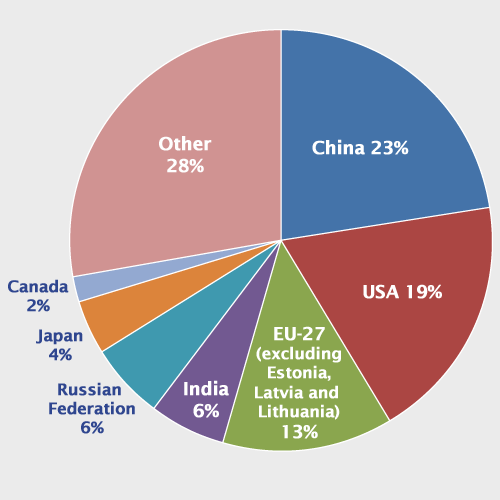From 2GreenEnergy Intern Oliver Goavec: Europeans and Americans Have Different Perceptions on Climate Change — Part Two of Three
International agreements concerning climate change are complicated because a consensus must be found. Since the first summit in 1972, four more have been held. In 1982, for the second summit in Nairobi, dealing with the Cold War was the main priority, thus Ronald Reagan decided for the U.S. to send his daughter as a representative. The failure of that summit was so huge that it is not really considered as officially having taken place.
The Rio conference in 1992 was the most successful UN meeting on climate change; thanks to it the Kyoto protocol came into being in 1997 and objectives to reduce gas emission for the 2008-2012 periods were established. It is interesting to highlight the U.S. exception: America was the only country that signed the protocol but never ratified it, because it didn’t constrain developing countries. The U.S. also imposed a system of trading emissions credits, although Europe was against that, and recommended a tax. The advantage of a trading system is its flexibility: if an entity in a given industry exceeds the amount of emissions permitted, it must pay or buy a pollution permit. Also, a tax would be more punitive: the more one pollutes, the more one pay.
The two other earth summits were in Johannesburg in 2002 and Rio+20 (2012).
On March 13th, 2001 in a letter to the Members of the Senate, U.S. president George W. Bush explained why the U.S. did not ratified the Kyoto protocol and describes the actions that he wants to set up:
“As you know, I oppose the Kyoto Protocol because it exempts 80 percent of the world, including major population centers such as China and India, from compliance, and would cause serious harm to the U.S. economy. The Senate’s vote, 95-0, shows that there is a clear consensus that the Kyoto Protocol is an unfair and ineffective means of addressing global climate change concerns. As you also know, I support a comprehensive and balanced national energy policy that takes into account the importance of improving air quality. Consistent with this balanced approach, I intend to work with the Congress on a multipollutant strategy to require power plants to reduce emissions of sulfur dioxide, nitrogen oxides, and mercury. Any such strategy would include phasing in reductions over a reasonable period of time, providing regulatory certainty, and offering market-based incentives to help industry meet the targets. I do not believe, however, that the government should impose on power plants mandatory emissions reductions for carbon dioxide, which is not a “pollutant” under the Clean Air Act.”
The fact is, even if 80% of the world is exempt of restrictions, the U.S. are the second CO2 emitter after China, as shown in this pie-chart (2008 figures).
Climate Change Perceptions in Europe, Contrasted to the U.S.Thinking that the U.S. is not sensitive to the concept of climate change issue is wrong. First, we have to distinguish between the U.S. federal government and the 50 states. Even if Barack Obama has a new vision about climate change that differs from his predecessors, there is a lack of federal measures to cut CO2 gas emissions.
In Europe, we think that the U.S. is among the worst performers in terms of renewable energy, because speeches by its government leaders failed to highlight the subject. If the U.S. had made more efforts earlier on, things would be easier today. Indeed, the U.S. is the first superpower in the world, and its opinions and choices have a great impact on the decision process of the others.
(Final part soon)


